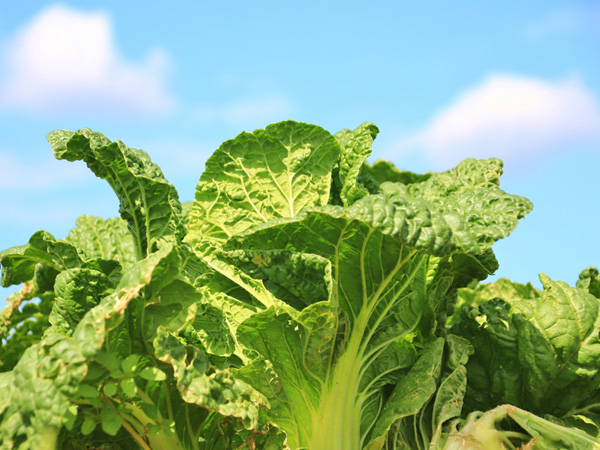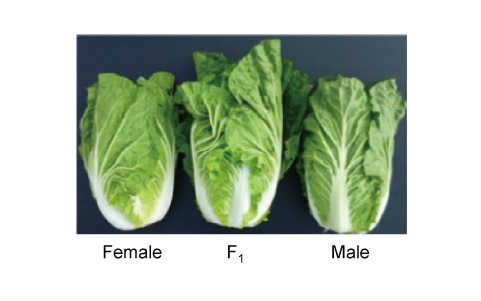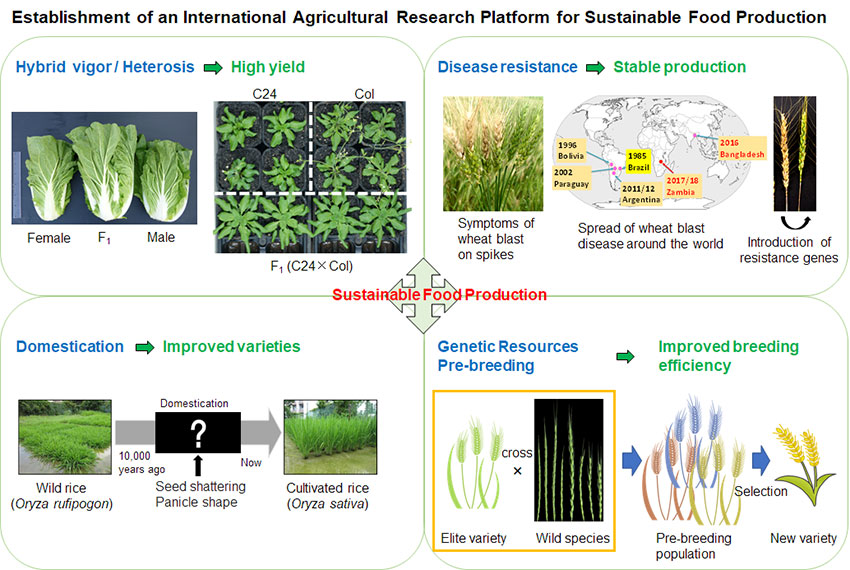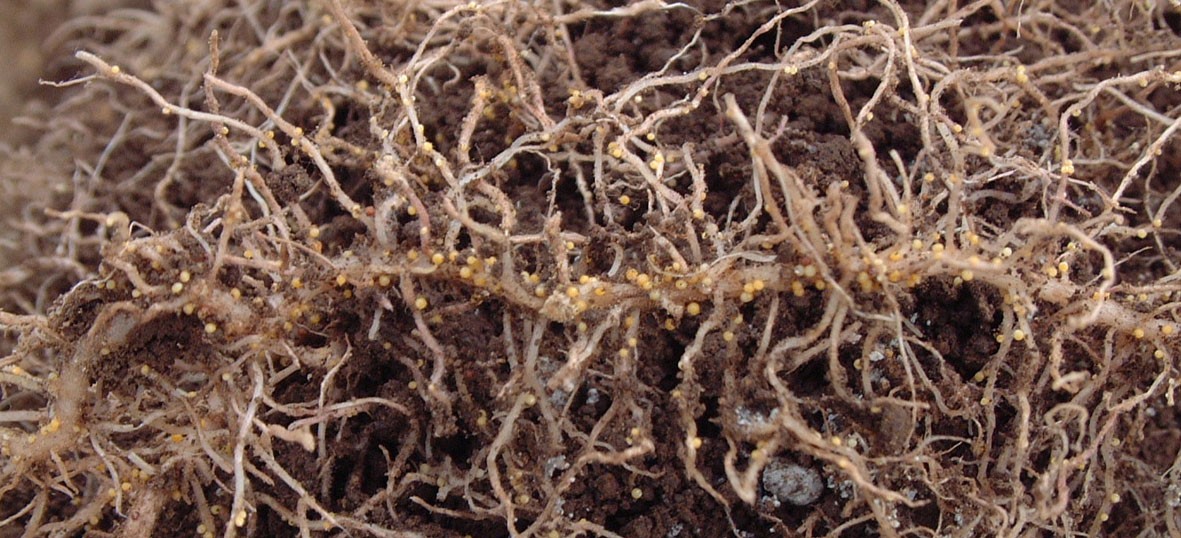Dr. MIYAJI Naomi, who after graduating from Kobe University doctorate in its Graduate School of Agricultural Science (currently a researcher at Iwate Biotechnology Research Center) and Ms. Mst. Arjina Akter, who is a Ph.D. student in the same doctorate program with their colleagues, elucidated that the alterations to gene expression induced after infection of Japanese mustard spinach by white rust disease were different in disease-resistant cultivar and disease-susceptible cultivar. These research results lay the groundwork for clarifying the disease resistance mechanism in Japanese mustard spinach through future research.
This research was a cooperation between Associate Professor FUJIMOTO Ryo of Kobe University Graduate School of Agricultural Science, Associate Professor CHUMA Izumi of Obihiro University of Agriculture and Veterinary Medicine, Department of Human Sciences, Iwate Biotechnology Research Center, Sylhet Agricultural University (Bangladesh) and the Commonwealth Scientific and Industrial Research Organisation (CSIRO) of Australia. These research results were published in the online version of Scientific Reports on May 26, 2023.
Main Points
- The research group discovered in Japanese mustard spinach (Brassica rapa var. perviridis) (a.k.a ‘Komatsuna’) that gene expression status was altered as a result of infection by white rust fungus.
- The study found that the genes whose expression was altered by infection by white rust fungus were different in the white rust fungus resistant cultivar and the disease-susceptible cultivar.
- While there was the induction of the genes for a defence response and gene expression related to salicylic acid in the resistant cultivar, no such tendency was observed in the disease-susceptible cultivar.
Background of the Research
White rust disease is one of the important diseases in cruciferous vegetables such as Japanese mustard spinach (Brassica rapa var. perviridis) and Chinese cabbage (B. rapa var. pekinensis). The disease caused by white rust fungus (Albugo candida) is characterised by the generation of lesions with a whitish suppuration appearing on the leaves, stems, stalks and flowers (FIG. 1). In the cruciferous vegetables such as Japanese mustard spinach and Chinese cabbage, the onset of the disease adversely affects quality such as the appearance and leads to the problem of greatly reduced product value. There are disease preventative and curative measures against white rust disease such as spraying with agrochemicals, but the most effective measure is to use disease resistant cultivars. For that reason, the development of resistant cultivars is a much-demanded outcome in agriculture.
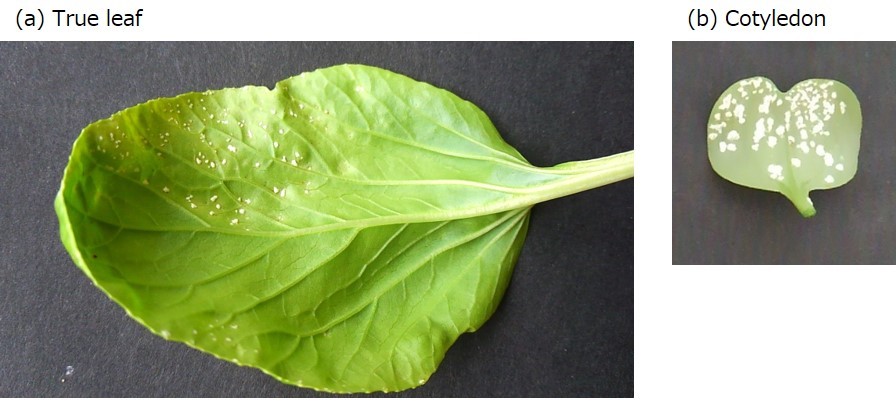
©Ryo Fujimoto (CC BY)
Plants grow, adapt and respond to the environment by controlling the expression of a variety of genes. To date, in a variety of plant species, it has become clear that resistance is induced in response to disease by the control of gene activity. On the other hand, it has not been clear how genes are expressed during infection of Japanese mustard spinach by white rust disease fungus, and it was not known whether there were differences in gene expression between cultivars which are strongly resistant to white rust disease and cultivars susceptible to the disease (disease susceptible cultivars).
Content of the research
The white rust disease causing fungus was inoculated to white rust disease resistant cultivar and white rust disease susceptible cultivar, and the gene expression before and after infection was analysed. Genes were identified which increased/decreased in the level of expression as a result of infection by white rust disease fungus, and the commonality of these genes across the cultivars was investigated (FIG.2). As a result, while there are genes which are common to resistant and susceptible cultivars, there were many genes which were specific to each type of cultivar.
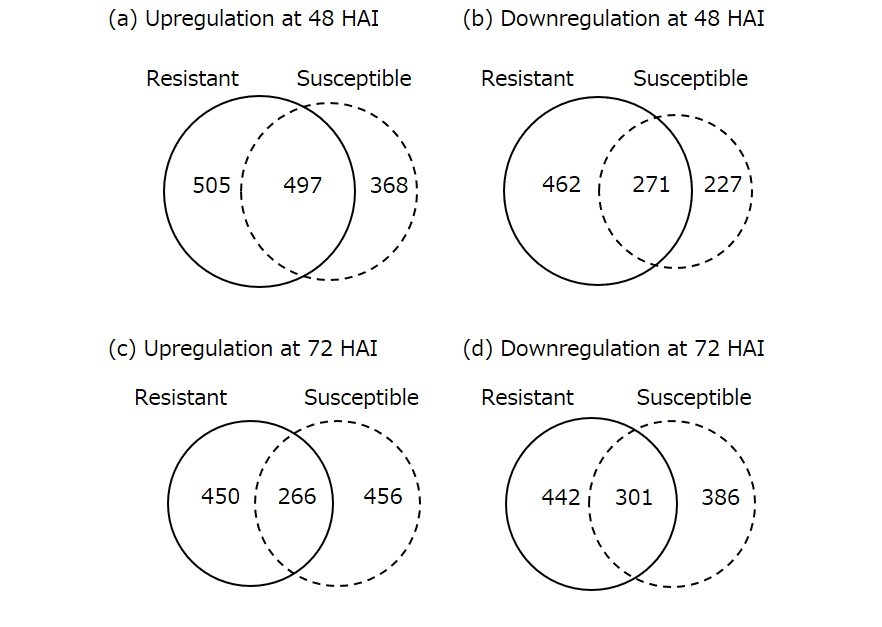
© Ryo Fujimoto (CC BY)
Next, by classification of known genes whose expression was altered by infection by the white rust disease fungus, the researchers were able to predict what kind of expression response was occurring in each variety. Many of the genes whose expression was altered in the resistant cultivar were classified into categories related to protective responses (whole organism protective resistance, programmed cell death/apoptosis, etc.) or categories related to salicylic acid. On the other hand, among the genes whose expression was altered in the disease susceptible cultivar, there were hardly any genes present which could be classified into these categories (FIG. 3).

© Ryo Fujimoto (CC BY)
Based on this research, it became clear that when infected by the white rust disease fungus, the genetic expression was different between the white rust disease resistant cultivars and the disease susceptible cultivars. Moreover, the expression of the salicylic acid response genes was altered when infected by the white rust disease fungus.
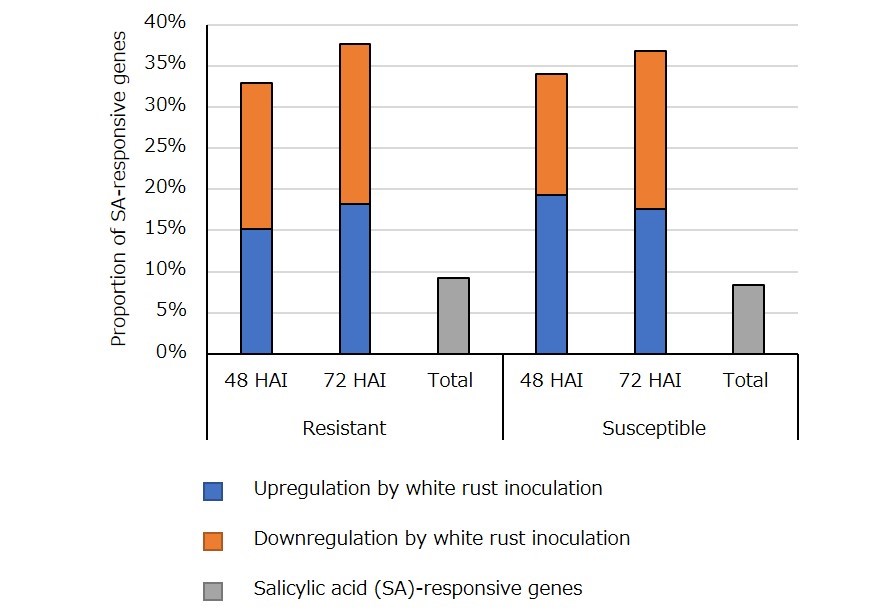
Among the SA-responsive genes, the ratio of genes whose expression were changed at 48 or 72 hours after white rust inoculation (HAI) were shown. “Total” represents the proportion of SA-responsive genes in all genes. © Ryo Fujimoto (CC BY)
Future developments
In relation to important gene candidates in the exhibition of white rust disease resistance derived in the research performed here, the research group aims to clarify the molecular mechanism of white rust disease resistance, by investigating the functionality of particular genes in respect of the disease response. Furthermore, they plan to identify white rust disease resistance gene, and develop white rust resistant cultivars.
Glossary
White rust disease
An important disease of cruciferous vegetables such as Japanese mustard spinach and Chinese cabbage (Brassica rapa L.) which is caused by the white rust disease fungus Albugo candida. It is characterized by generation of lesions causing white suppuration on the leaves, stems, stalks and flowers. The onset of the disease of leafy vegetables, such as Japanese mustard spinach, is often observed at harvesting, resulting in a significant loss of commercial and rendering the vegetable unshippable.
Genetic expression
Genes are coded in DNA comprised of the four types of bases, adenine (A), thymine (T), guanine (G) and cytosine (C). Genes are expressed by the generation of mRNA (transcription) by RNA polymerase using the DNA gene domains as templates. Proteins are produced by translation of the mRNA.
Salicylic acid
A plant hormone. It is widely related to control of the stress response and development processes such as the immune response and maturation.
Acknowledgments
This research was in receipt of the following support:
Bio-oriented Technology Research Advancement Institution/Research Program on Development of Innovative Technology (JPJ007097)
Japanese Society for the promotion of science, Invitational Fellowships for Research in Japan (Long Term) (L19543)
Japanese Society for the promotion of science, Research fellowships for Young Scientists Research fellowships for Young Scientists (DC1) (18J20027)
Kobe University Grants in-Aid for Scientific Research, Strengthening International Joint Research, Type B
G7 Scholarship Foundation, R&D Assistance Operations
Original publication
Miyaji et al.: Differences in the transcriptional immune response to Albugo candida between white rust resistant and susceptible cultivars in Brassica rapa L. Scientific Reports (2023). DOI: 10.1038/s41598-023-35205-5







